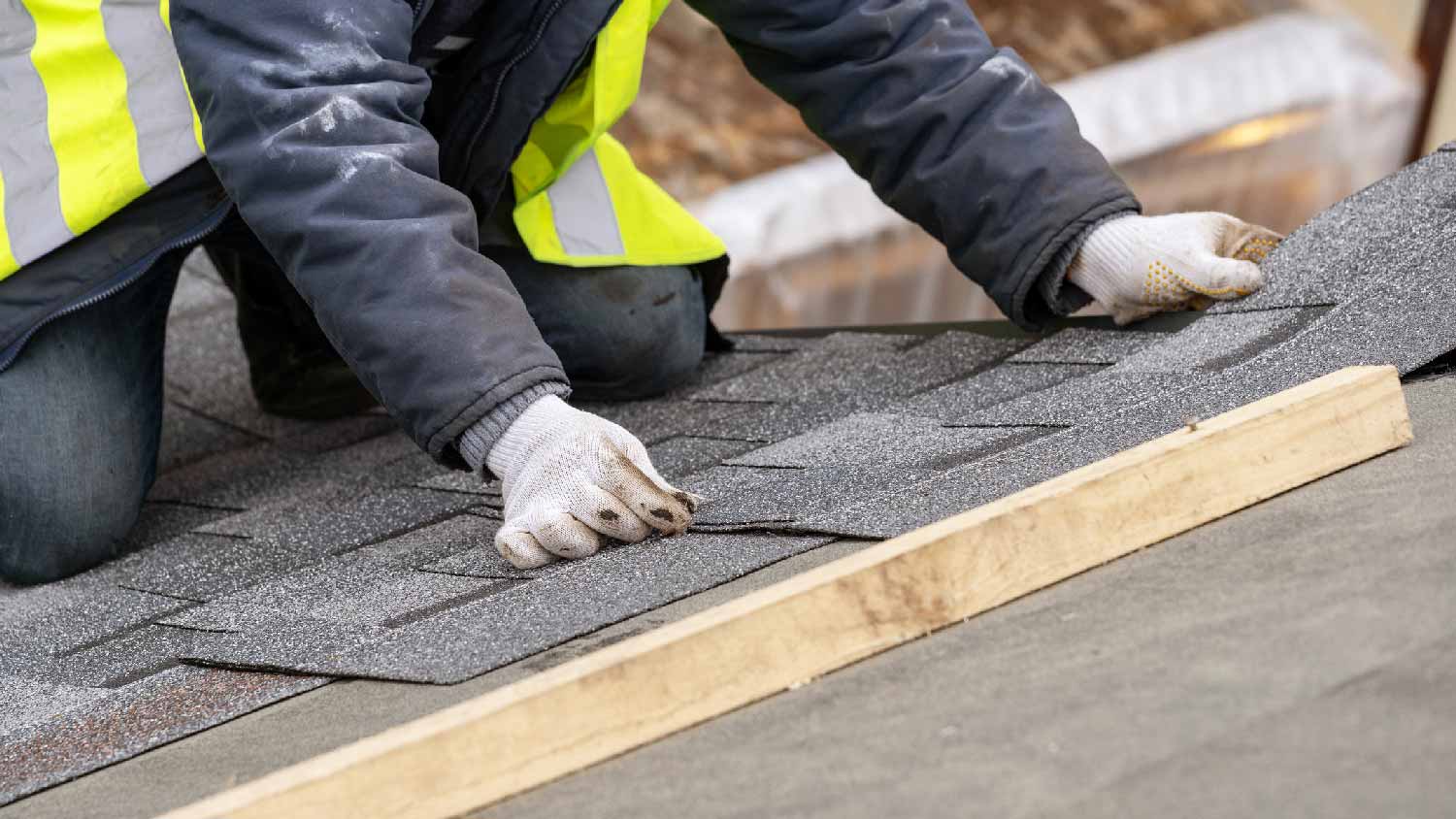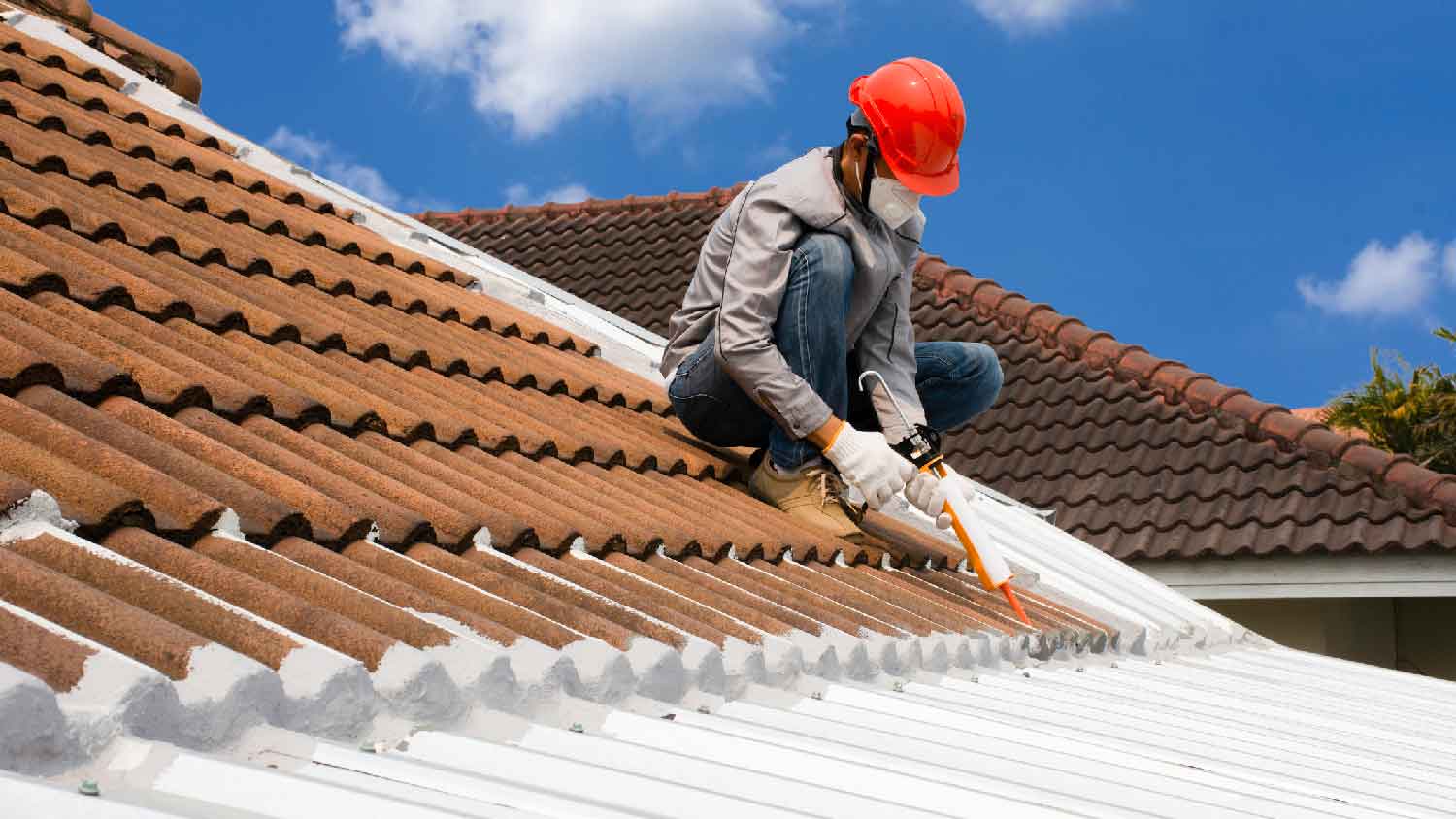How to Repair Wind-Damaged Shingles
Don’t let those gusts get you down


Many people assume that rain and snow cause the most roof damage, but high winds can lift off shingles or send tree branches and other debris flying into your roof, causing significant destruction. Since your roof protects your home from the elements, it's crucial to make repairs as soon as you become aware of any damage to prevent further structural problems.
Why Do I Have to Repair Wind-Damaged Shingles?
Your shingles are one of your home’s first lines of defense against the elements. If you don’t repair them in a timely fashion, your roof could begin leaking, which can lead to water damage, mold, or property damage. These repairs will be much more expensive than what you’d pay to repair or replace a few torn shingles. If it gets to the point where you need a full roof replacement, you will need to shell out an average of $9,100.
How Much Does It Cost to Repair Wind-Damaged Shingles?
To tackle this project by yourself, you can expect to spend between $100 and $500, depending on the scope and the type of shingles you’re working with.
If you wish to hire a professional, the cost to repair a roof averages between $391 and $1,894. You can also get an estimate from a local storm damage repair company.
Signs of Wind-Damaged Shingles
Are you unsure if your shingles suffered damage after a storm or evening of high winds? Look for these tell-tale signs.
Granule debris: Asphalt shingles have small granules on their surface to protect your roof from UV rays and other things; a small amount of granule loss is normal, but if after a windstorm you notice excessive scattering, you should consider replacing any shingles with significant granule loss.
Missing shingles: Obviously, if any of your shingles go missing, you should replace them.
Damaged shingles: Shingles might not go missing, but could instead be badly damaged from wind, which can lead to tears, peeling, lifting, and more.
Damage from debris: If a tree branch or other debris falls on your roof, it will likely damage your shingles.
Water inside: If any water is coming into your attic after a storm, it’s likely your shingles were damaged and not able to perform their job properly—which is to keep water out of your home to prevent water damage. The cost for water damage restoration is $3,750, on average.
How to Repair Wind-Damaged Shingles

Learn to repair wind-damaged shingles to get your roof back to tip-top shape.
Caulk Curling Shingles
Asphalt shingles can begin to curl as they age, and wind can exacerbate this. The wind can lift up a side or corner of the shingle, putting your roof at risk for water damage and other problems. Follow these steps to fix any asphalt shingles that are curling away from the roof.
Use a caulking gun to apply roofing sealant under the corner that’s lifting
Weigh the shingle down with a brick
Leave the brick on the shingle for 24 hours while the sealant dries
Remove bricks
Repair Any Tears
If your shingle has been torn by wind, you can repair it using sealant. However, this is only for asphalt shingles with small tears or cracks; more extensive damage might require a shingle replacement.
Apply a thick bead of roofing sealant under the crack
Hold the shingle down and apply a second bead of sealant on top of the crack or tear
Using a putty knife, spread the sealant over the shingle
Allow the sealant to dry for 24 hours
Replace Badly Damaged or Missing Shingles
It’s possible the wind has damaged your shingles to the point of no return or knocked them off completely. If this is the case, you should remove and replace any damaged shingles with new ones.
Using a pry bar and working carefully, lift the tab of the shingle above the damaged shingle to expose the nails
Remove the nails from the damaged shingle using a pry bar and a hammer
Pull the damaged shingle out; you will discard it
Position the new shingle in place
Using roofing nails and a hammer, hammer the nails along the tar strip of the new roofing shingle; typically, each shingle requires four nails, but each shingle has its own nailing pattern. If you are in doubt, consult the manufacturer’s website
Using your caulking gun, drop a few dabs of roofing cement on the tar strip of the replacement shingle to secure it in place
Replace the nails of the surrounding shingles and make sure to re-cement them down as well
How to Prevent Wind Damage to Your Shingles

While sometimes wind damage is unavoidable—as might be the case with a history-making storm—but there are steps you can take to prevent wind damage or at least keep the damage to a minimum.
1. Seal Your Roof
If it isn’t already, have the edge of your roof sealed with roofing cement to prevent winds from getting underneath the roof and lifting off shingles.
2. Install Windproof Sheathing
Roof sheathing is your second line of defense against high winds. Make sure your sheathing is windproof.
3. Inspect and Maintain Your Roof
Once a year, have your roof inspected for any cracked, worn, curling, or missing shingles. Check for any water damage underneath the roof, as water damage can weaken the roof and make it susceptible to wind and other elements. Once your roof is reaching its maximum life span, have it replaced—don’t wait for disaster to strike.
4. Prune Back Trees
Prune trees so that wind can’t knock them onto your roof, which can cause significant structural damage. Check the general area around your home for other objects or debris that might be able to fly onto your roof and damage it and be sure to remove it.
DIY vs. Hiring a Pro
If you want to take the DIY road and keep your roof repair costs down, it’s possible to remove and replace damaged shingles on your own—you can expect to spend $100 and $500 on this project. Know, though, that roof repairs can be dangerous and require safety equipment to protect you in case you slip and fall. You might also replace the shingles incorrectly and exacerbate any issues that already exist.
If you don’t want to take any risks, hire a nearby professional roofing contractor. An expert contractor will be able to identify the kind of shingles you have and perform the appropriate repair for them. The cost to hire a pro to repair your shingles averages $975, but the final price will depend on the materials, scope of the work, and other factors.
Frequently Asked Questions
Flapping shingles, or shingles that are lifting or curling away from your roof, can be glued back into place using roofing cement or sealant. Apply the glue underneath the shingle, then press it down firmly. You can leave a brick on top of the shingle to hold it in place overnight while the sealant dries.
Shingle damage comes in many forms, and the damage usually depends on the wind speed and the shape of the roof before the winds. Typically, when shingles are damaged by wind, they become torn, creased, or detached from the roof. Some might go missing entirely. More extensive roof damage might occur if a tree branch or other debris has fallen onto the roof as a result of the windstorm.
Most manufacturers’ warranties do not cover wind damage to roof shingles, but some companies include a wind warranty rider in their warranty offer. You can purchase this rider to protect yourself, your wallet, and your roof from any damage that might occur from wind. Be sure to read all the fine print and understand any limitations of the warranty.















